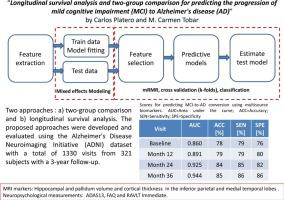Journal of Neuroscience Methods ( IF 2.7 ) Pub Date : 2020-06-10 , DOI: 10.1016/j.jneumeth.2020.108698 Carlos Platero 1 , M Carmen Tobar 1

|
Background
Longitudinal studies using structural magnetic resonance imaging (MRI) and neuropsychological measurements (NMs) allow a noninvasive means of following the subtle anatomical changes occurring during the evolution of AD.
New Method
This paper compared two approaches for the construction of longitudinal predictive models: a) two-group comparison between converter and nonconverter MCI subjects and b) longitudinal survival analysis. Predictive models combined MRI-based markers with NMs and included demographic and clinical information as covariates. Both approaches employed linear mixed effects modeling to capture the longitudinal trajectories of the markers. The two-group comparison approaches used linear discriminant analysis and the survival analysis used risk ratios obtained from the extended Cox model and logistic regression.
Results
The proposed approaches were developed and evaluated using the Alzheimer's Disease Neuroimaging Initiative (ADNI) dataset with a total of 1330 visits from 321 subjects. With both approaches, a very small number of features were selected. These markers are easily interpretable, generating robust, verifiable and reliable predictive models. Our best models predicted conversion with 78% accuracy at baseline (AUC = 0.860, 79% sensitivity, 76% specificity). As more visits were made, longitudinal predictive models improved their predictions with 85% accuracy (AUC = 0.944, 86% sensitivity, 85% specificity).
Comparison with Existing Method
Unlike the recently published models, there was also an improvement in the prediction accuracy of the conversion to AD when considering the longitudinal trajectory of the patients.
Conclusions
The survival-based predictive models showed a better balance between sensitivity and specificity with respect to the models based on the two-group comparison approach.
中文翻译:

纵向生存分析和两组比较可预测轻度认知障碍向阿尔茨海默氏病的进展。
背景
使用结构磁共振成像(MRI)和神经心理学测量(NMs)进行的纵向研究提供了一种无创的方法来跟踪AD进化过程中发生的细微解剖变化。
新方法
本文比较了两种构建纵向预测模型的方法:a)转化者和非转化者MCI受试者之间的两组比较,以及b)纵向生存率分析。预测模型将基于MRI的标记与NM相结合,并包括人口统计学和临床信息作为协变量。两种方法都采用线性混合效果建模来捕获标记的纵向轨迹。两组比较方法使用线性判别分析,生存分析使用从扩展Cox模型和logistic回归获得的风险比。
结果
拟议的方法是使用阿尔茨海默氏病神经影像学倡议(ADNI)数据集开发和评估的,来自321名受试者的总共1330次就诊。两种方法都选择了很少的特征。这些标记易于解释,可以生成可靠,可验证和可靠的预测模型。我们的最佳模型预测在基线时的转化率将达到78%的准确度(AUC = 0.860,灵敏度为79%,特异性为76%)。随着更多的访问,纵向预测模型以85%的准确性(AUC = 0.944,86%的敏感性,85%的特异性)改善了他们的预测。
与现有方法的比较
与最近发布的模型不同,在考虑患者的纵向轨迹时,AD转换的预测准确性也有所提高。
结论
与基于两组比较的模型相比,基于生存的预测模型在敏感性和特异性之间显示出更好的平衡。











































 京公网安备 11010802027423号
京公网安备 11010802027423号